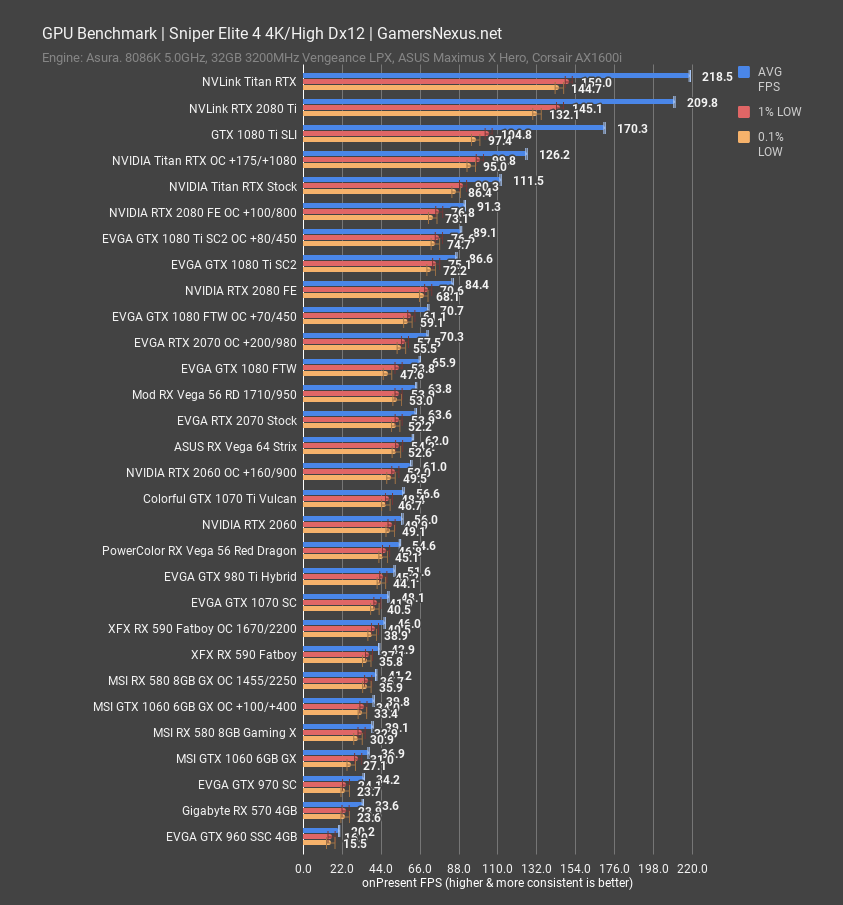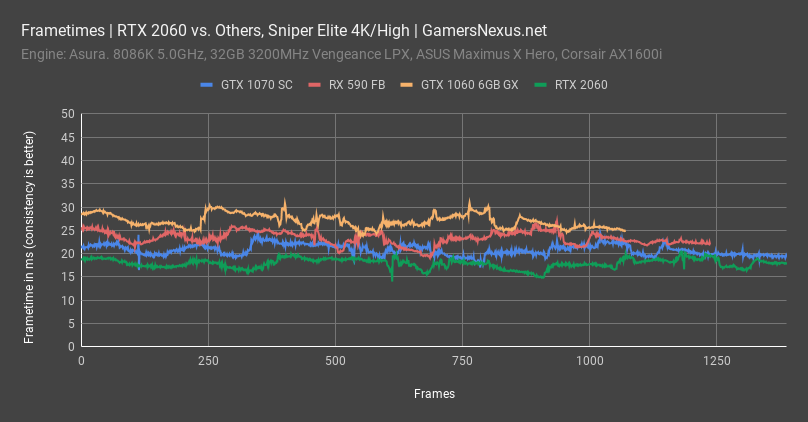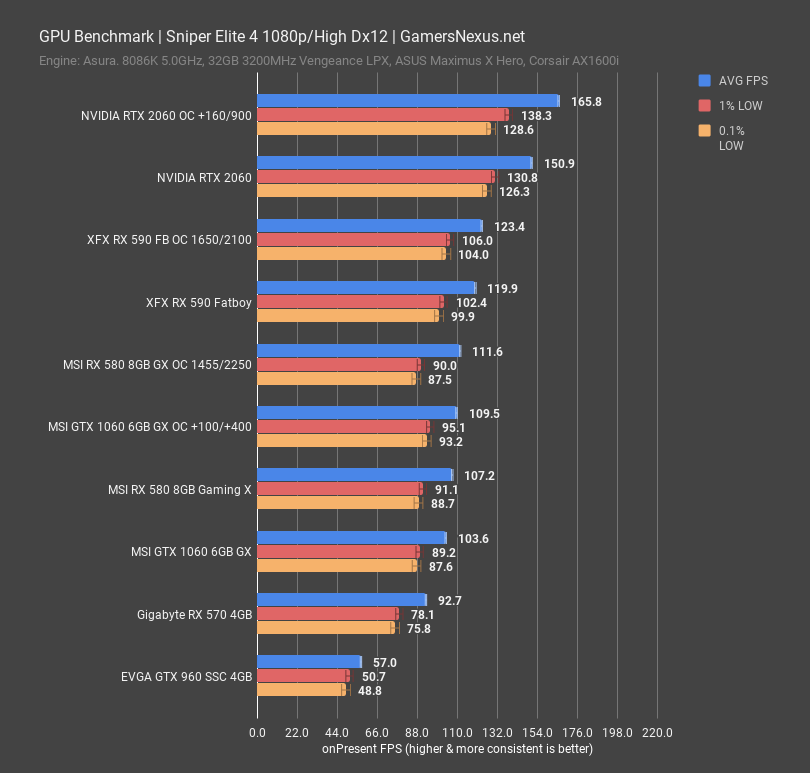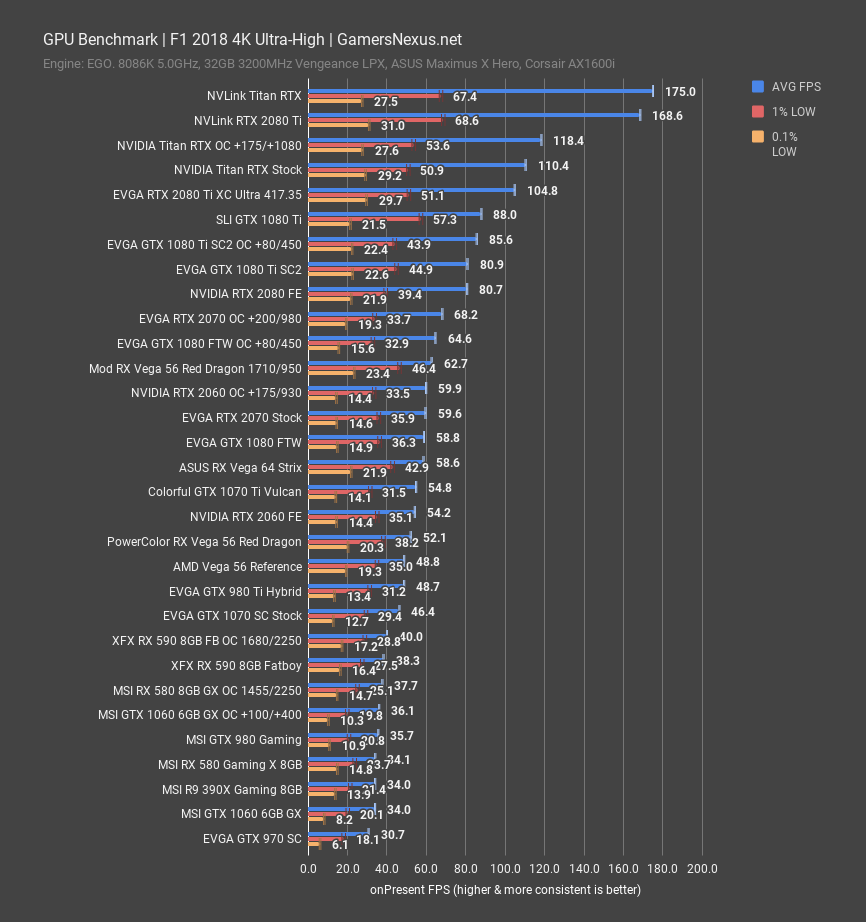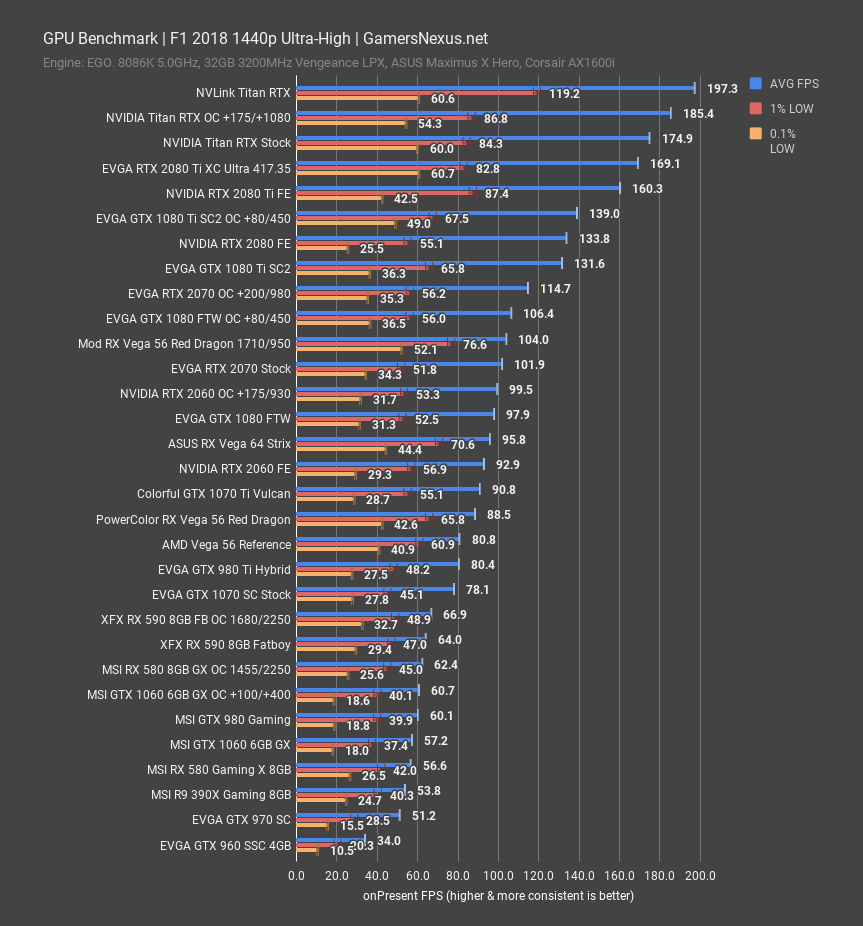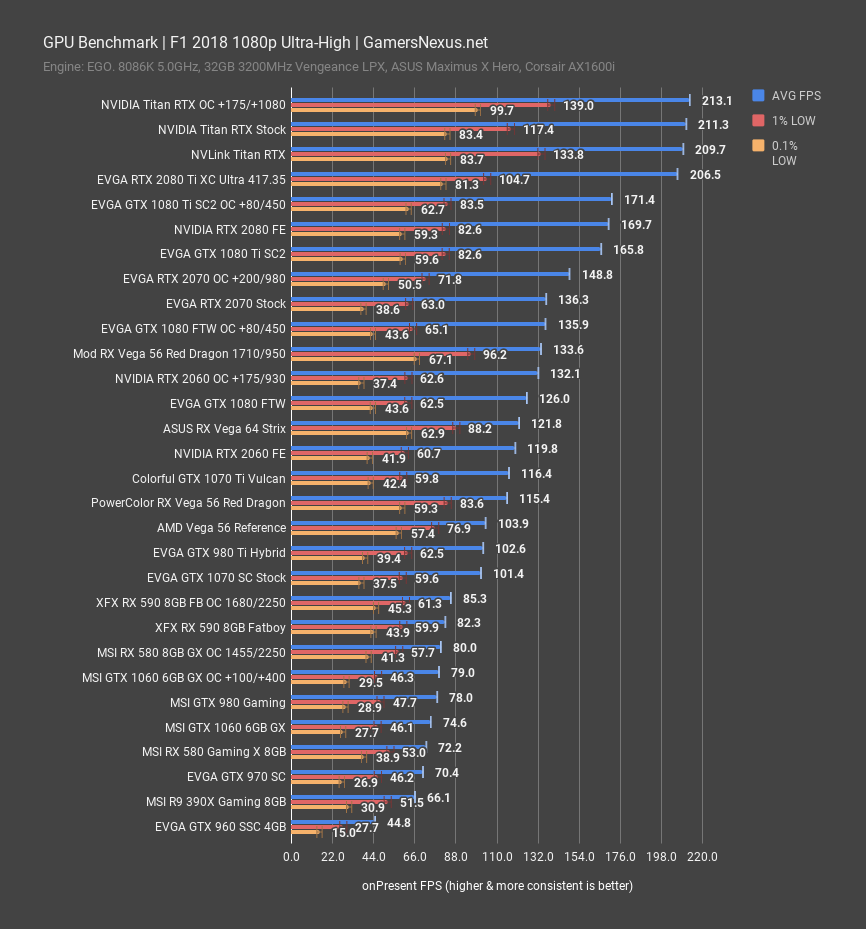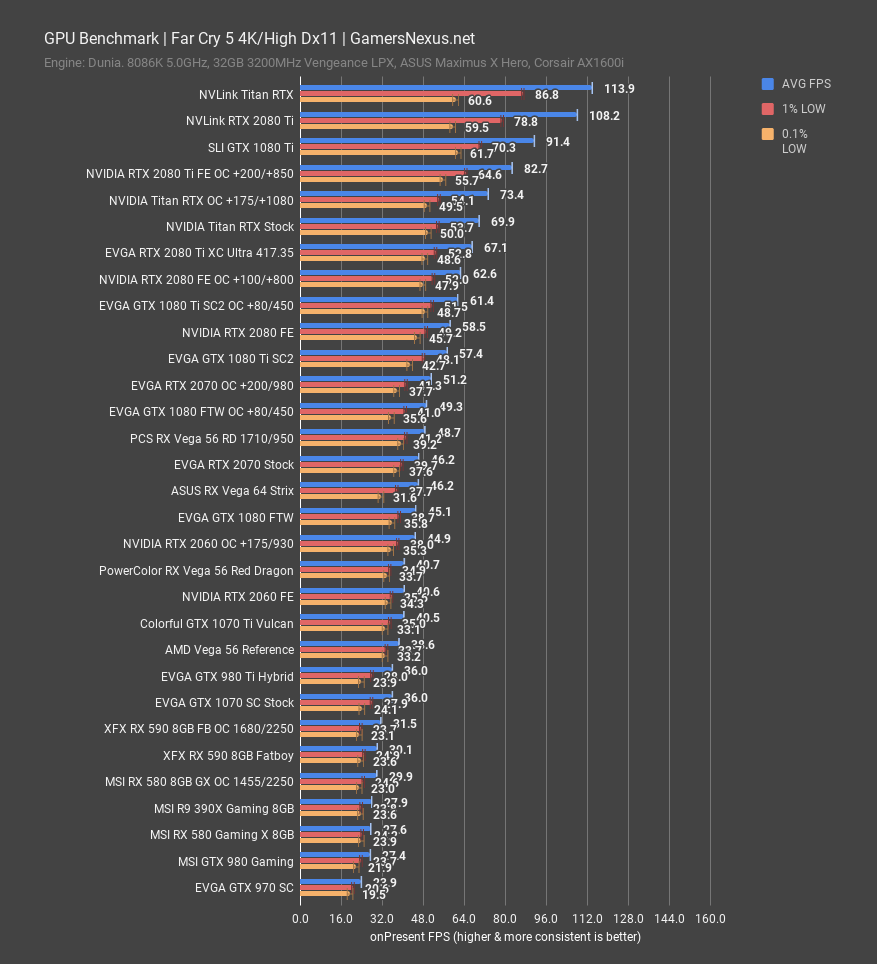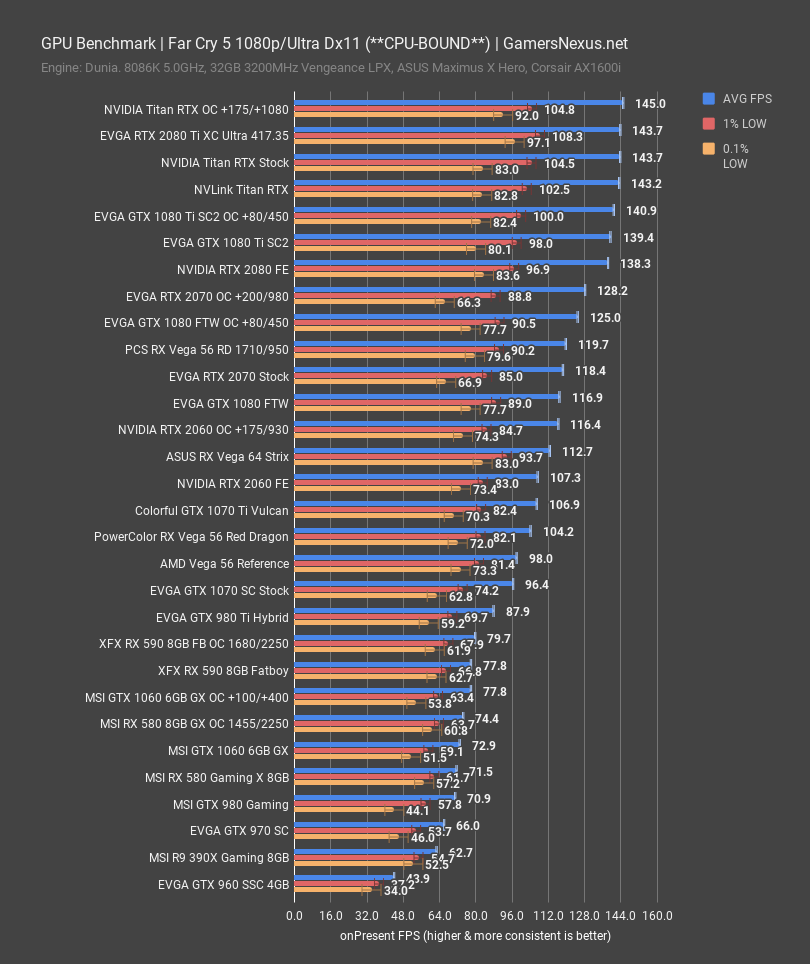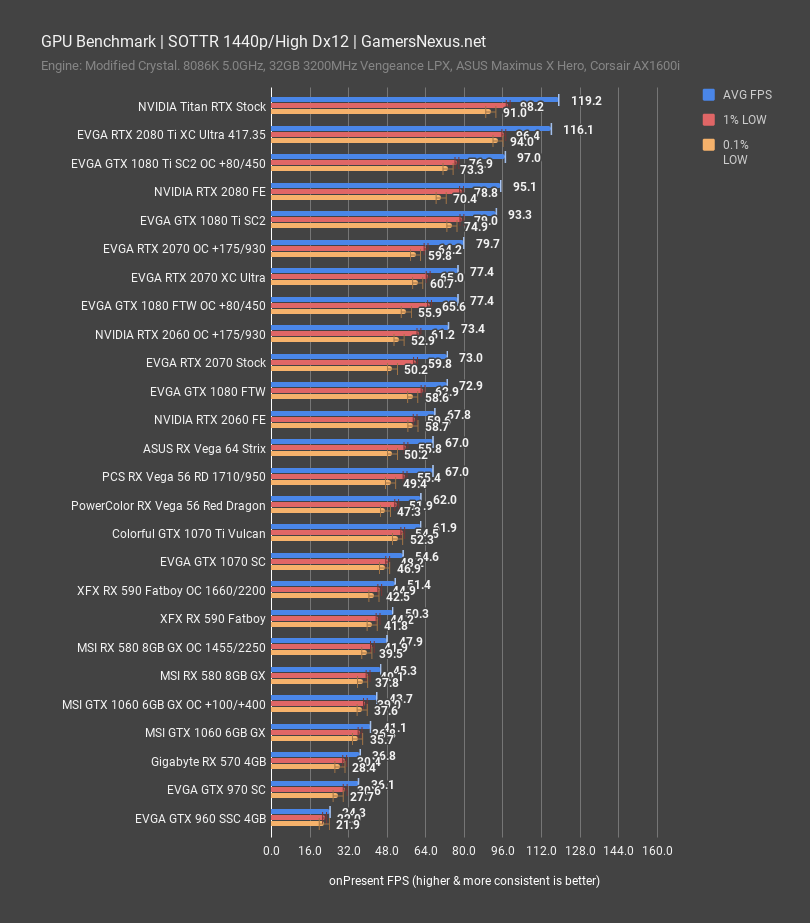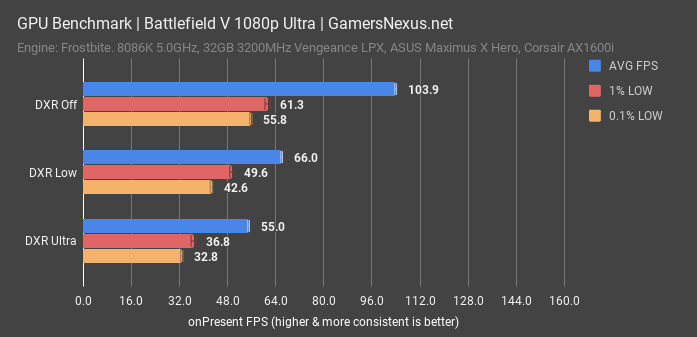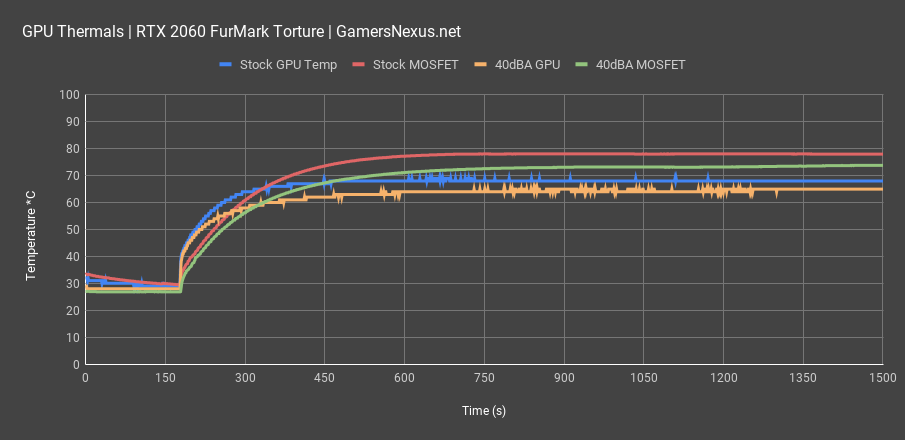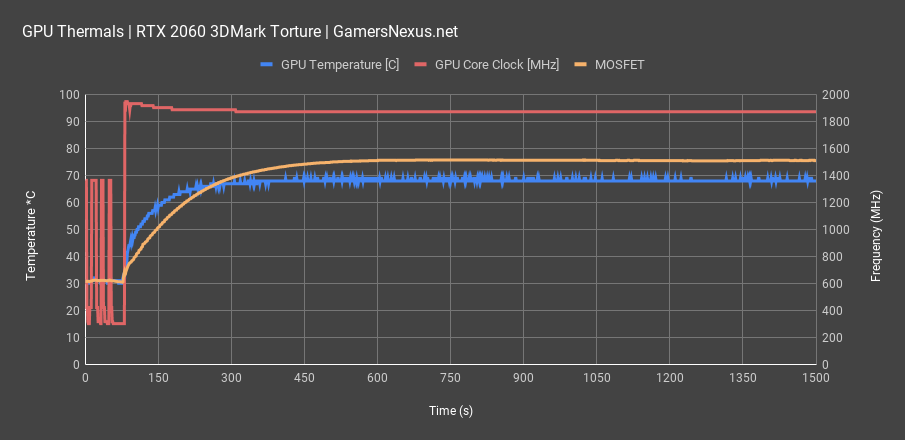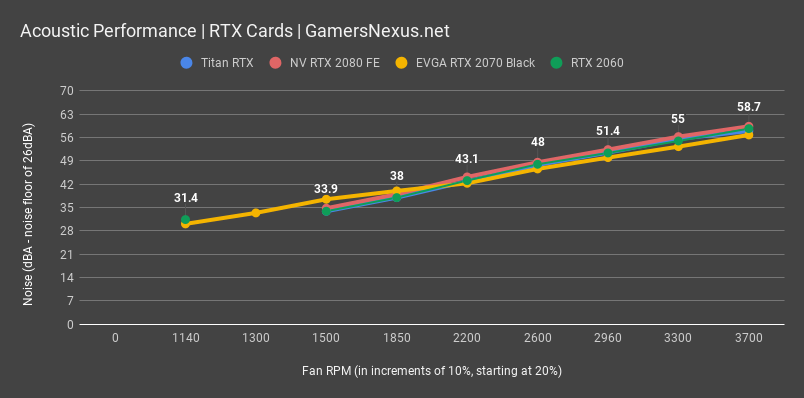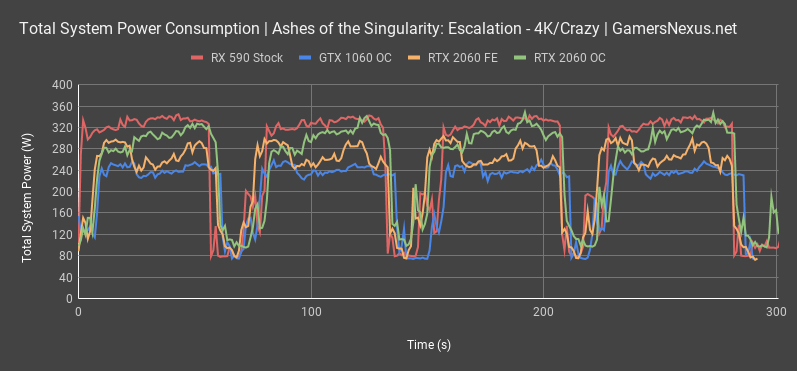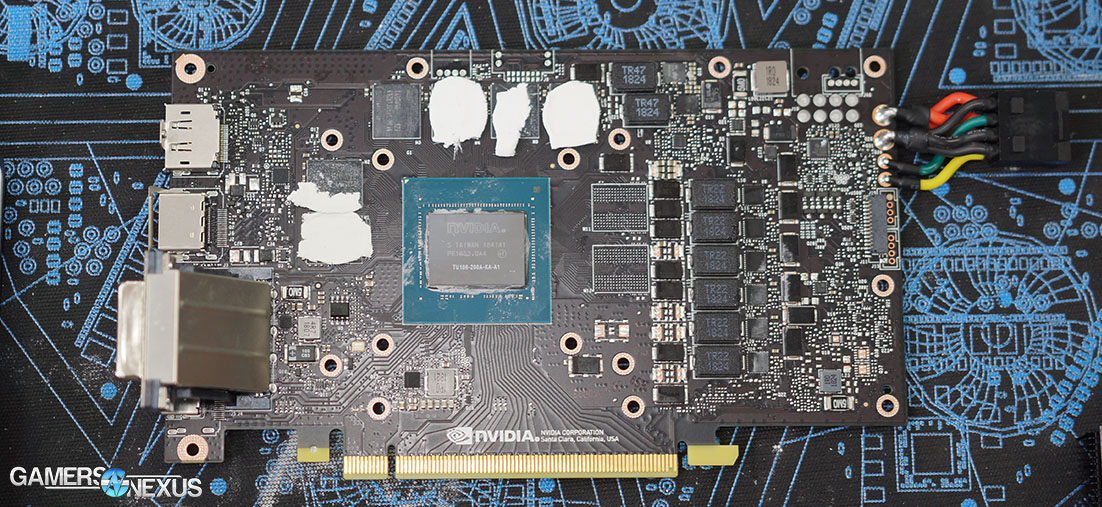Today we’re reviewing the RTX 2060, with additional tests on if an RTX 2060 has enough performance to really run games with ray-tracing – basically Battlefield, at this point – on the TU106 GPU. We have a separate tear-down going live showing the even more insane cooler assembly of the RTX 2060, besting the previous complexity of the RTX 2080 Ti, but today’s focus will be on performance in gaming, thermals, RTX performance, power consumption, and acoustics of the Founders Edition cooler.
The RTX 2060 Founders Edition card is priced at $350 and, unlike previous FE launches in this generation, it is also the price floor. Cards will start at $350 – no more special FE pricing – and scale based upon partner cost. We will primarily be judging price-to-performance based upon the $350 point, so more expensive cards would need to be judged independently.
Our content outline for this RTX 2060 review looks like this:
- Games: DX12, DX11
- RTX in BF V
- Thermals
- Noise
- Power
We’re putting more effort into the written conclusion for this one than typically, so be sure to check that as well. Note that we have a separate video upload on the YouTube channel for a tear-down of the card. The PCB, for the record, is an RTX 2070 FE PCB. Same thing.
Sniper Elite 4 Benchmark – RTX 2060 vs. GTX 1070 Ti, RTX 2070, Vega 56
Sniper Elite 4 is our first test. This one was chosen because of its well-implemented low-level API access and bypass to the normal abstraction layers presented by both wrappers and Dx11. We’ll start with our 4K test for a baseline with the most data to compare against.
At 4K, Sniper Elite 4 has the stock RTX 2060 at 56FPS AVG, with lows well-timed at 50 and 49FPS 1% and 0.1% low, respectively. This is indicative of consistent frametime performance, something we’ll look at next. Overclocking the RTX 2060 to a 160MHz offset – because 175MHz was unstable in this game – landed it at 61FPS AVG, a gain of approximately 8.9%. Not bad. The EVGA RTX 2070 low-end model, for perspective, performs at 64FPS AVG, which is only 4% ahead of the overclocked RX 2060; granted, overclocking the 2070 furthers its lead to 70FPS AVG, but the point is that the 2060 is nearly achieving 2070 levels of performance when the former is overclocked. The RX 590 ends up at about 43FPS AVG when stock, allowing the 2060 a lead of about 31% over the 590. It also has a price difference, but we’ll talk about that in the conclusion.
This positioning of the 2060 puts Vega 64 just barely ahead of it, and functionally tied with the 2060 overclocked. The 1070 Ti also equates 2060 levels of performance, with Vega 56 not distant when stock. Generationally, the RTX 2060 outperforms the GTX 1060 6GB Gaming X and its 37FPS AVG by 52%. That’s a massive lead, and some of that is because of the 2060’s improved capabilities with asynchronous command queuing. Sniper 4 also benefits from the boosted memory bandwidth on the 2060, although the 50% increase in lanes on the vectors also helps. Over the GTX 960 SSC, 4K performance has improved measurably from 20FPS AVG to 56FPS AVG. Higher resolution throughput has seen heavy focus over the past two generations.
We’ll look at frametime performance next. As a reminder, frametime charts are the most representative look at real experience, displaying a frame-to-frame interval for every instant of gameplay. This helps us look at data that would get averaged-out in bar charts, and best illustrates performance for each individual frame present. Lower is better, but more consistent is more important.
Starting with a plot of the GTX 1060 6GB Gaming X from last generation, we see a line plot that sits between 25ms and 32ms, with overall frame-to-frame pacing deviating no greater than 1-2ms per frame. The framerate isn’t that good, as we saw in the previous chart, but the frametime consistency is about as good as it gets. Lowering resolution solves the framerate issue, but frametime consistency is the difficult aspect to get correct. The RX 590 plots next, showing improved framerate by way of a 20-27ms frametime average, also nearing peak consistency. The GTX 1070 plots better framerate than both of these, nearing 20ms average, and is the best performer up until we plot the RTX 2060. The RTX 2060 sits between 15ms and 20ms on average, with 16.667ms representing a 60FPS average. The 2060, like the previous cards, has overall excellent frametime consistency and would present minimal “hitching” or stuttering in this title.
1080p should be more interesting from a generational scaling standpoint: The RTX 2060 ends up at 151FPS AVG stock, which scales 46% over the GTX 1060 6GB stock card, or 165% over the GTX 960 SSC. The GTX 1060 scaled 82% over the GTX 960 SSC, for perspective. The difference is that the price has moved with the RTX 2060, whereas the pricing of the GTX 960 and GTX 1060 were similar at launch: The 960’s launch price was about $200 to $240, with the 1060 at about $240 to $250 and the 2060 at $350.
F1 2018 – RTX 2060 Benchmark vs. RX 590, GTX 1060, GTX 960
F1 2018 gives us a look at a well-built DirectX 11 title. At 4K, F1 2018 places the RTX 2060 FE at 54FPS AVG, just ahead of the Vega 56 Red Dragon and 980 Ti Hybrid from two generations ago. The overclocked RTX 2060 with a +175 core offset ends up above tied with the stock RTX 2070, but note that this core offset is difficult to sustain without good cooling. The 2070, of course, outpaces the 2060 when overclocked, maintaining a lead at 68FPS AVG and of 14% when both are overclocked. Versus the stock GTX 1060 from last generation, the 2060 stock card maintains a 59% improvement. The GTX 960 isn’t on this chart due to limited ability to run at 4K. The RX 590 ends up at 38FPS AVG stock, nearer the GTX 1070 than the 2060.
At 1440p, the RTX 2060 ends up at 93FPS AVG stock, posting excellent 1440p performance and relatively playable 4K performance. This is similar to the GTX 1070 Ti, the two being imperceptible different, and just behind Vega 64. Versus the GTX 1060, the 2060 posts a gain of 62%, which is more than what we saw at 4K. The 2060 leads the 960 SSC by 173%. Finally, an overclock on the 2060 gets it to nearing error margins of the RTX 2070 stock card’s 102FPS AVG.
Running 1080p instead, we need to pay attention to the scaling gaps between the XX60 generations. The RTX 2060 places at 120FPS AVG, which leads the GTX 1060 Gaming X by 61%, within error of our last distance measured. The 2060 leads the GTX 960 by 167%, down marginally from the lead at a higher resolution. For reference, Vega 56 runs 115FPS AVG, which is imperceptibly different from the 1070 Ti and nearing the 2060. The RX 590 is far behind at 82FPS AVG.
Far Cry 5 – RTX 2060 Benchmark vs. RX 590, GTX 1060, GTX 960, GTX 980 Ti
Far Cry 5 uses the Ubisoft Dunia engine and is our next benchmark, stressing the geometry pipeline and putting load on the cards by way of screen space reflections and geometric complexity.
Running 4K, the RTX 2060 ends up at 41FPS AVG. Dropping settings would allow this to be playable, but it may make more sense to go down to 1440p. Either way, scaling positions this as again functionally equivalent to the 1070 Ti – it’s within margin of error – and Vega 56. The 2070 is ahead by a bit, but both cards are having trouble with this workload at 4K.
1440p shows the same positioning: The 2060 places within error of the 1070 Ti, is led by Vega 64, but is now led more significantly by the 2070, which holds a lead of 12%. Overclocking the 2060 pushes it to 82FPS AVG, or roughly tied with the stock 2070. Vega 56 is outside of perceptible differences versus the 2060, with the RX 590 trailing notably behind at 55FPS AVG. For perspective, the GTX 960 is at the bottom of the chart.
At 1080p, the 2060 ends up over 100FPS AVG when stock, falling between the 1070 Ti and Vega 64, not distant from the GTX 1080 FTW. Generational improvement versus the stock GTX 1060’s 73FPS AVG posts a 47% lead – not as big as we’ve seen elsewhere, but still a tremendous leap. The GTX 960 SSC operated 44FPS AVG in the same test, demonstrating how far we’ve come by allowing the 2060 to pull a 144% lead. Again, that’s not quite as large a lead as in other tests, and helps illustrate that the 2060’s biggest improvements over Maxwell is in higher resolution performance.
Shadow of the Tomb Raider – RTX 2060 vs. GTX 960, Vega 56, RTX 2070
Shadow of the Tomb Raider uses a modified Crystal Engine and should eventually get some RTX implementation, but for today, we’re testing just with high settings and TAA across all three resolutions. We disabled AA in some SLI testing, but those aren’t relevant for this comparison.
The RTX 2060 ends up at 37FPS AVG, between Vega 56 and the GTX 1080. Overclocking the 2060 pushes it to 40FPS, so it’s still struggling. We’ll need more than just a settings drop to get reasonable framerate out of this game, as evidenced by the 2070’s baseline performance of 41FPS AVG, right near the overclocked 2060.
Let’s drop to 1440p. At 1440p, the RTX 2060 runs a 68FPS AVG, now playable, and maintains 1% and 0.1% low performance also nearing 60. This kind of tighter frametime consistency is indicative of an overall smooth framerate, with no stutters interval-to-interval. The 2060 leads the 1060 6GB’s 41FPS AVG by 65%, further leading the GTX 960 SSC by 179%. The RX 590 runs closer to the GTX 1070, with the RTX 2070 stock card being tied by the overclocked RTX 2060. This makes a compelling argument for buying a cheaper 2060 and overclocking it in order to achieve 2070 performance. Just for reference in this chart, we also included the XC Ultra 2070 data. We’d been culling it for chart length reasons, but it clearly illustrates that higher-end 2070s will outperform the cheaper model.
GTA V – RTX 2060 Benchmark vs. RX 590
Battlefield V RTX On vs. Off Benchmark on RTX 2060
With Battlefield V, the RTX 2060 tested in singleplayer with DXR off, on low, and on Ultra. Note that this is after the recent performance-improving patch, so BF V is at peak performance.
With DXR fully disabled, we measured 104FPS AVG when using ultra settings, with frame buffering disabled and all post processing in the “basic” tab disabled, like chromatic aberration. Frametimes sustained at 61FPS 1% and 56FPS 0.1%. DXR on low put us at 66FPS AVG, with DXR on ultra dropping to 55FPS, allowing 0.1% to hit 33FPS AVG.
We’ll give the 2060 credit where it’s due: It is able to play this game at 1080p and roughly 60FPS with ray-tracing enabled, although it does lose about 40% of its performance in doing so.
RTX 2060 Founders Edition Review – Thermals & Noise
Let’s get into thermals. For this, we disassembled the RTX 2060 and attached thermocouples to PCB components. We have some broll of the disassembly we can show – it’s insane the amount of effort required to take this card apart, and NVIDIA’s use of hot glue to hold in fan cables doesn’t make things easier. Actually, it’s hot glue and 7 screws to hold in the fan cable, not to mention the rest of the heatsink-fan assembly. The PCB is the same as an RTX 2070 PCB, just simplified and with some removed memory modules, so we already knew the hotspot MOSFETs from the 2070 PCB.
Starting first with FurMark for torture thermals, we measured the stock GPU temperature as at 68 degrees Celsius throughout the test, with ambient at 22 degrees +/-1. For our regulars, this isn’t over ambient – it’s just 68 degrees. Setting the fan noise to 40dBA for normalized noise levels with our other tests, we see GPU temperature fall to 64 degrees Celsius. NVIDIA’s default fan profile leans more toward quiet than cool, and so 40dBA – a reasonable noise level – actually brings a reduction in thermals, which isn’t all that common. MOSFET temperatures end up at 78 degrees Celsius for the stock card, which is within spec and reasonable, or 73 degrees for the 40dBA variant on testing. These MOSFET thermals are fine and are well within specification for the components used. We won’t bother plotting this, but for the curious, the auto fan speed was 1700RPM, or about 45%. 40dBA fan speeds are at about 52%.
For the next chart, we’re looking at 3Dmark Firestrike Extreme performance over a prolonged period. The point is to see how the core clock behaves when under a gaming workload, as some clocks will bounce around more heavily based upon load. First plotting the temperature, we see GPU core temperature at 69-70 degrees on the left axis, with MOSFET temperature at 76 degrees on the left axis. The frequency line comes in next, starting initially at 1935MHz – and remember, this is stock, so that’s a high frequency – and dropping almost immediately to 1875MHz once at steady state. Frequency sustains at this level in nearly a perfect line, which is rare and good. The drop from 1935MHz is because GPU core temperature steadily rises from 30 degrees, driving down frequency pursuant to boost behavior. Every couple of degrees matters for frequency. Overall, though, NVIDIA is doing better on this card than its previous designs, and that’s because the TDP is lower overall for the GPU core than the 2080 series.
As for noise levels, we’re starting at a lower baseline of 32% -- or 1190RPM – with the RTX 2060, whereas the previous RTX cards had a floor of 41% (1525RPM). The RTX 2060 has the same acoustic performance as the other RTX coolers, more or less, but does plot idle noise lower at 31.4dBA. The average load fan speed is about 1670RPM in 22 degrees ambient, putting fan speeds at around 37dBA. 100% load puts the RTX 2060 at 58.7dBA. It’s still louder than a good aftermarket cooler, but similar to low-end coolers like the EVGA 2070 Black. Remember that decibels are logarithmic, so these increases are non-linear. People tend to start noticing noise changes with roughly every 3dBA increase.
RTX 2060 Power Consumption vs. GTX 1060, RX 590
Finally, for power consumption, we’re looking at total system power draw with a heavily controlled test bench. All voltages are controlled on the motherboard, ensuring no fluctuations that would throw off measurements. This is not individual card draw, but an over-time plot of total system draw.
First, the RTX 2060 ends up at about 260W to 300W total system power consumption, occasionally spiking to 310W. The average sustained high is about 300W. Overclocking the GPU pushes the system to 360W peak, but the average sustained high is closer to 320W when the 2060 is overclocked. The GTX 1060 Gaming X with an overclock pushes about 240W total system power draw, for perspective, so NVIDIA has gone up generationally alongside its performance. TDP was previously 120W and is now 160W, by NVIDIA’s spec, and the power consumption difference is visible here. This is still below the RX 590’s total system power consumption of 320-330W, but not by much. We won’t plot it since it’d make the chart too busy, but note also that the RTX 2070 is roughly the same as the RTX 2060. It’s about 10-20W higher on average.
Conclusion: Is the RTX 2060 Worth It?
NVIDIA’s stance with the RTX 2060 is significantly more powerful than its RTX 2080 launch. The RTX 2060 is more reasonably balanced in its price-to-performance “ratio,” managing to make significant generational gains in performance without the severity of friendly fire competition that the RTX 2080 faced from the GTX 1080 Ti. The RTX 2060 also is technically capable of using its namesake RTX feature in Battlefield V. We didn’t particularly like DICE’s implementation of RTX to begin with, but there’s no doubt that it’s intensive and, after the recent updates, the RTX 2060 is able to actually enable the setting without being completely unplayable. This, we think, is important: Even if most people don’t use RTX on the RTX 2060, it’d be a major credibility hit to launch an RTX 2060 that could not reasonably play games with RTX enabled, so well done by NVIDIA and DICE to make that feasible. Now, to be fair, Battlefield V is a shooter, and it’s an odd one to trade a 40% performance hit for some ultimately minor graphics changes, but that’s a different topic.
The RTX 2060 significantly bolsters its performance over the GTX 960, for holders-on of Maxwell, with over 2x gains across the board (often ~170% gains). Improvement over the GTX 1060 is also noteworthy, commonly at 50%. This is accompanied by an increase in price and power consumption, mind you, so there is still some brand migration of the SKU naming towards higher price categories, but the 2060 is more justifiable at its launch positioning than the RTX 2080.
The 2060 ends up at $350 baseline, no more FE pricing, and so is $100 over the initial GTX 1060 launch price (cards are now closer to $210) and about $140 over initial GTX 960 launch pricing. The card is also $150 cheaper than the RTX 2070, but critically can be overclocked (with relative ease) to nearly equate RTX 2070 performance in rasterization, which is how most games operate. For anyone who wants an RTX 2070 in performance but doesn’t have the funds, the RTX 2060 seems a good mid-step that can be pushed the rest of the way there. Of course, a 2070 can overclock and outperform the 2060 OC, but the point more comes down to money.
AMD’s competition would be the flanking RX Vega 56 and Vega 64 cards, with some not-quite-comparable competition from the RX 590, occupying a price class that should remain largely unaffected by the RTX 2060’s $350 products. The RX 590 remains commendable for the ~$260 range (with a few per-game exceptions), with fierce competition from cheaper GTX 1060s, but neither is a direct competitor to the 2060. Vega 56 is commonly priced at around $370 (for the Red Dragon we recently worked with), making it tough competition.
Here’s how we would break-down an increasingly complex product stack:
- At $250, we’d point toward the RX 590. If GTX 1060 6GB cards are available in your region for around $200, they are strong points of consideration and we’d choose based on game; otherwise, we’d default to the RX 590 in most instances.
- At $350, for someone who wants to open a box and use the product, the RTX 2060 is a good choice and stronger than NVIDIA’s previous positioning, but its pricing structure and naming scheme have again migrated north.
- At $350, for someone who enjoys tweaking and overclocking, the RX Vega 56 cards get our firm recommendation. We recently pushed Vega 56 to RTX 2070 performance and had a blast doing it. Our version of this was completely impractical (in that it may kill the card faster than otherwise), but it’s the most fun we’ve had OCing a card in recent launches. For the folks who care less about straight gaming performance and care more about enthusiast tweaking, Vega 56 takes an easy victory. NVIDIA is simply too locked-down to win in this category.
That’s how we look at it. The RTX 2060 is better positioned, but much of the luster of a higher performance is stolen by higher price. It is a worthwhile buy in the use cases we’ve described above, which is far more than we could have said for the RTX 2080 at launch. RTX as a technology remains unproven at this point, with two loose implementations that leave much to be desired, so we’d advise against purchasing solely on the promise of wider-spread RTX and instead focusing on price-to-performance in traditional games. Game developers are a different story.
The RTX 2060 gets a soft recommendation from us, as its competition – even friendly fire competition – is multivarious and complicated. NVIDIA has done well to improve its market position with the RTX 2060. We are leaning positive on the RTX 2060, and moves to shift toward adaptive sync support (e.g. FreeSync) will yield good community response.
One more note that’s specific to the Founders Edition cooler: The cooler design is utterly, completely insane. NVIDIA seems lost in cooler design. The 2080 FE coolers used over 70 screws, if you remember (and we do), and the 2060 takes a similar approach. Curiously, the 2060 manages to do worse, namely by resorting to hot glue to hold the fan cable in place, not to mention the 7 screws used to further secure the fan cable. The PCIe connector is positioned right-side, past the PCB, which required an approach similar to the GTX 1060’s soldered power extension to the PCIe connector. Together, these two design approaches render the RTX 2060 Founders Edition card effectively impossible for a novice to service, e.g. for thermal paste replacement or dead fan replacement, and difficult for an expert to service. The card is becoming further Apple-like in design, and that’s not a good thing.
If buying the RTX 2060, we’d encourage board partners who know better how to build a cooler. We can, though, soft-recommend the RTX 2060, just take a good look at nearby price alternatives and think about your use cases. The RTX 2060 recovers NVIDIA's positioning for its RTX series and sets it back on track with a stronger product portfolio.
Editorial, Testing: Steve Burke
Video: Josh Svoboda, Andrew Coleman
